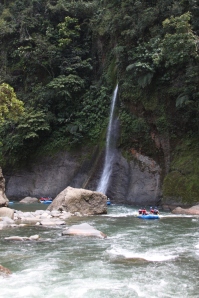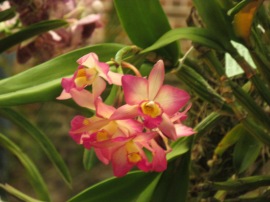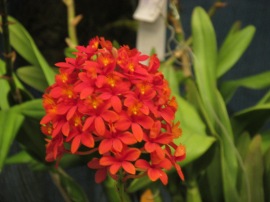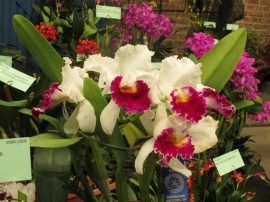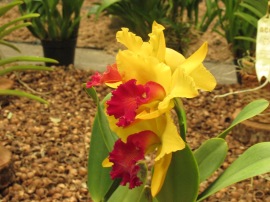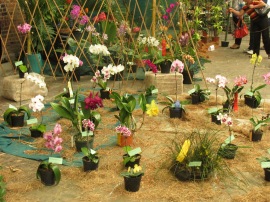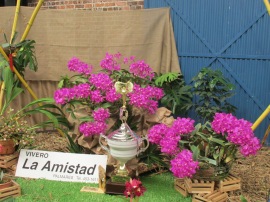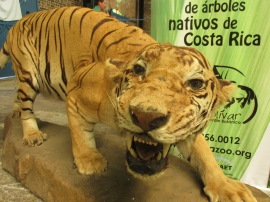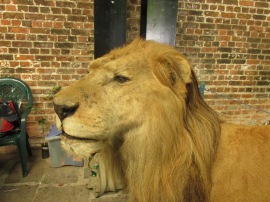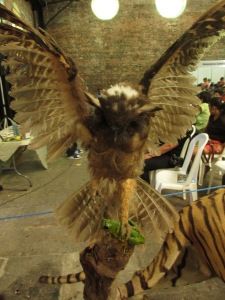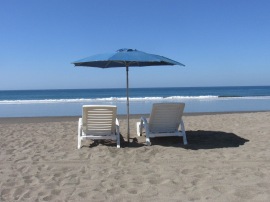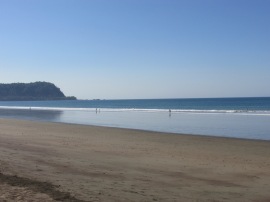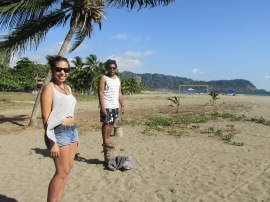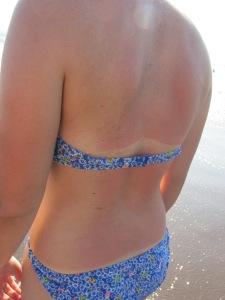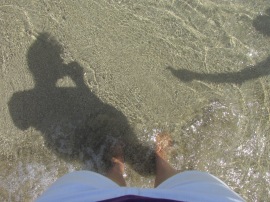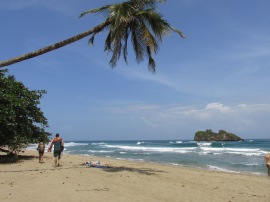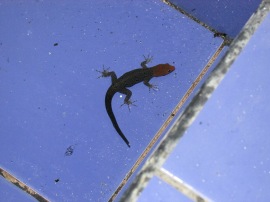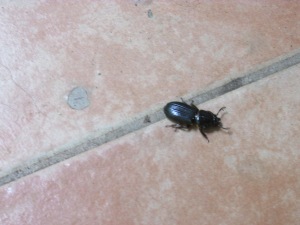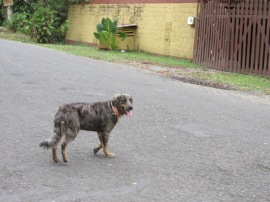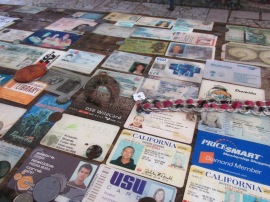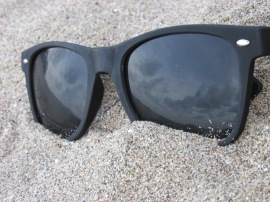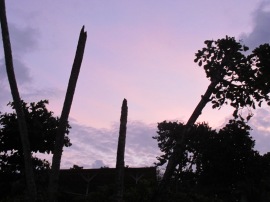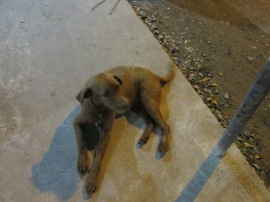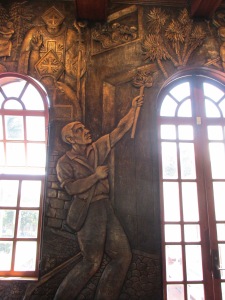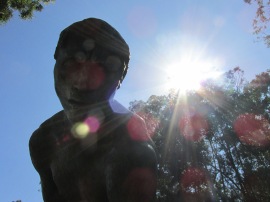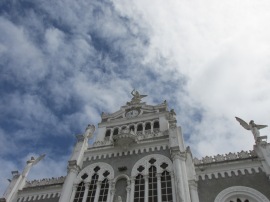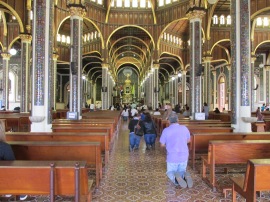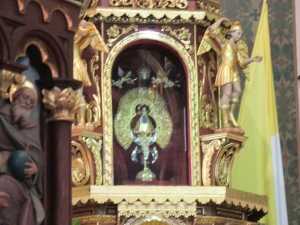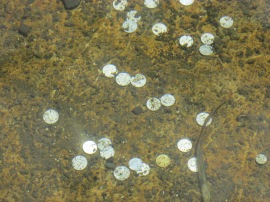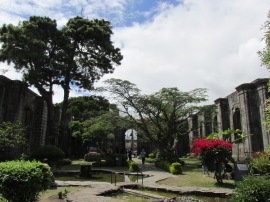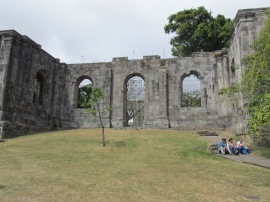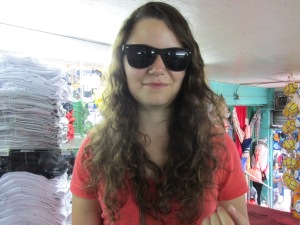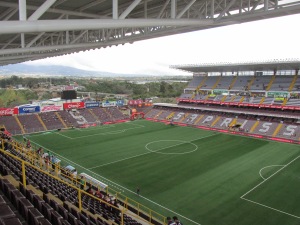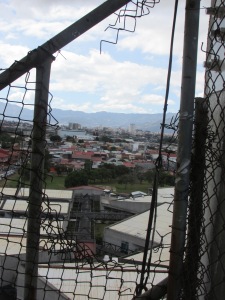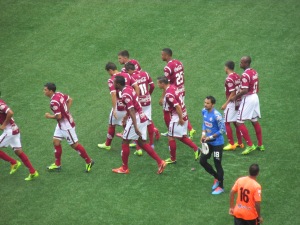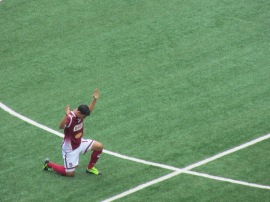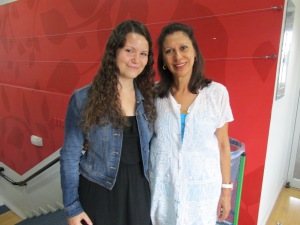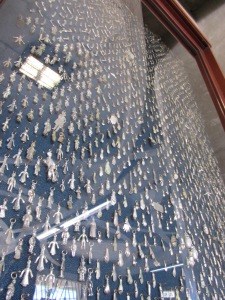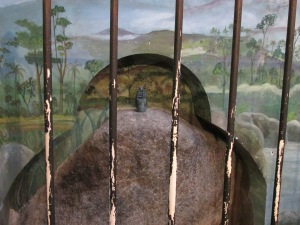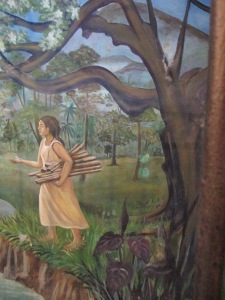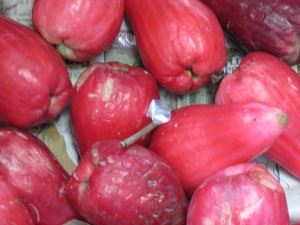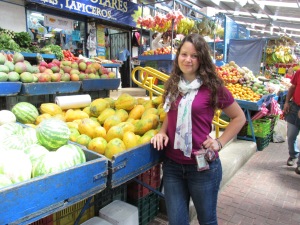
Volcán Arenal (right) looms outside our hotel, the summit frosted with clouds.
This post is a little delayed, but I wanted to share with you all the details of the most amazing, adrelin-filled weekend I’ve had in Costa Rica so far.
The fun started Friday, when we made our way to La Fortuna, a small town at the base of Volcán Arenal, Costa Rica’s most active volcano. While Arenal appears to have entered a resting phase, it is still known for some devastating activity in the 20th century. For example, in 1968 after hundreds of years of dormancy, it unexpectedly erupted and destroyed the town of Tabacón. As a result of consistent lava flow, one side of the volcano is green while the other is black from volcanic ash.
After check-in, we went to the Baldi Hot Springs, a nearby resort that houses thermal mineral waters heated geothermally by Arenal. Though this wasn’t the authentic cave pool experience I had hoped for, it was still very relaxing being able to wander from pool to pool, the water ranging from refreshing and cool to steamy and scalding. They also had some amazing water slides, including one that ends in a funnel like a toilet bowl!
Once we returned from Baldi, a bunch of us went out to a nearby club. It took a while for other people to show up, but I got to dance a little salsa with a Tico named José by the end of the night. I’ve been looking for a real chance to test my new dancing “skills.”

The La Fortuna Waterfall plummets down to its base, filling a small pool with cool, refreshing water.
The next morning we got up early and hiked down to the La Fortuna waterfall. I think there is an official connection between waterfalls and stairs in Costa Rica. Though my quads were killing me by the time we got back, the trek was well worth the experience.
The waterfall was absolutely gorgeous, crashing down into a rocky pool. I still can’t believe I swam at the base of a waterfall! Though admittedly I stayed close to the edge because I’m not a very strong swimmer. Still, the cool water and the sound of it rushing into the pool reminded me of how in the summer my family and I (along with our dogs) take quick dips in the river across the street from our house on hot days. While my friends were complaining about the cold, I couldn’t stop thinking how perfect it was!
On our way back to the hotel, our guide Jorge brought us to a rope swing next to a nearby bridge. It was a blast, but my only thought was, Don’t let go before you clear the rocks!
We had some time to kill before making our way to Monteverde, so a few of my friends and I decided to find el café de mi papa tica, Down to Earth Coffee, in La Fortuna. Matías greeted us before we even walked through the door, then exclaimed, “And this, this is my daughter!” giving me a big hug. Before giving us an orientation on how to test coffee for quality and strength, he warned us that we would leave the shop as “coffee snobs.” He first demonstrated the importance of density and color when it comes to brewing coffee, comparing his coffee to Café Rey, the most popular brand in Costa Rica. Matías showed us first that quality coffee should actually sink to the bottom of a cup as it should be
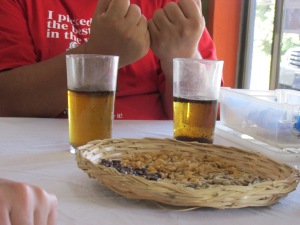
Guess which coffee is stronger! Remember: density and color.
denser than water. Second, pure coffee with no chemicals should take minutes rather than seconds to begin changing the color of the water. Third, stronger coffee should remain a transparent, amber color rather than simply darken to brown, as most people would think. Matías also taught us about the importance of a hard bean and how to recognize the altitude at which coffee is grown based on bean texture.
Next, we went through a step-by-step sensory tasting of his light roast. Matías instructed us to pay attention to three things: aroma, body and acidity. He said that his coffee should have a nutty, chocolate or mixed scent based on your usual taste preferences. Next, he asked us to “spray our palettes,” tipping the small dose of coffee on its side and quickly “spraying” our mouths with just a small bit.

From left to right: Mi papa tico Matías, Amari, Karan, me and Danielle after our orientation at Down to Earth Coffee.
As we did this, Matías told us to pay attention to the body of the coffee, which is the feel of it in your mouth, and also how the acidity causes you to salivate.
After our orientation and some espresso, Matías treated each of us to a drink of choice. I went with the chocolate-banana-coffee shake. He made it at home once, but I can honestly say it was even better at the café! I also bought my first bag of chocolate-covered coffee beans, which I’ll be sure to stock up on before going back to the States.
We said our goodbyes and made our way back to the hotel, where we boarded a bus that took us to Lake Arenal. We crossed it by boat, which gave us even more spectacular views of the volcano.
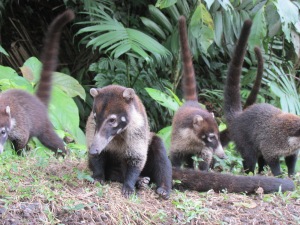
We came across a band of coatis on our way to Lake Arenal. These are slowly but surely becoming my favorite animals, aside from dogs!
Though the boat ride went pretty smooth, the second bus ride that brought us to Monteverde was anything but. For at least an hour, we drove on unpaved and essentially one-lane roads. Some would say it’s a great part of the experience to drive on such a bumpy, natural road. All I could think about was kissing the ground as soon as we stopped.
The highlight of the trip came Sunday morning. We made our way to 100% Aventura Canopy Tour and went zip lining through the Monteverde Cloud Forest! After receiving instructions from our guide who taught us the difference between “pura vida” and “no pura vida,” we finally got to test it out. It was absolutely amazing and so majestic – it reinforced my faith in God. I’ve never been afraid of heights; only falling, which I feel is a bit more rational. But that was the farthest thing from my mind as I glided through forests and over valleys. I even rode tandem on the longest zipline in Latin America – it was 1590 meters long, just shy of a mile! It didn’t feel like it but I was probably going at least sixty miles an hour over the valley. It was one of those times where you could almost step outside your mind and see yourself as a tiny speck on a thin string dangling above the earth, with epic Lord of the Rings or Harry Potter music playing in the background.
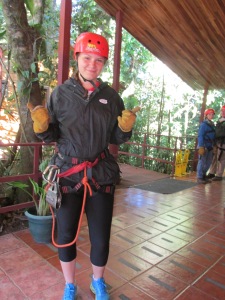
The before picture: geared up and ready to go!
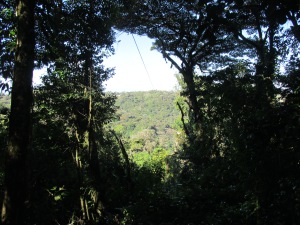
Trees break to reveal the start of the longest zip line in Latin America.
As if that wasn’t enough, I decided to try the Tarzan swing. Basically what happens is you step off this platform over one hundred feet above the ground and free-fall for a few seconds before slowing down as you swing back and forth.
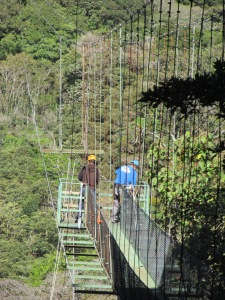
The platform that leads to the Tarzan swing hangs suspended by cables over a hundred feet above the ground.
While I admit I jumped the gun with the question of what I should hold onto, I was basically a robot after I made my way out to the platform. My mind went blank as I listened to the guide’s instructions telling me to grab the rope, wait for the gate to open and lean back. I felt a little nudge forward and I was off, my peripheral vision dead as I plummeted towards the ground and the trees on the other side. I let myself scream to prove to myself that there was still air moving through my system – but it was totally wicked! I think I found a piece of pura vida on that swing.
Jorge had one last surprise for us as we made our way back to our hotel.
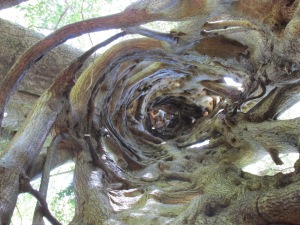
This special climbing tree twists and turns with (hopefully) nature-made footholds and handholds.
Just off the road outside of Monteverde, there is a tree (or trees?) that grew so as to form an upward tunnel with its branches, making it a perfect climbing tree complete with handholds and footholds. I didn’t make it all the way up, but it was cool to think I might actually be inside a tree.
My time in Monteverde wrapped up with an adorable, but teething, puppy, papaya y banana fresco, and one of the most adorable children I have ever met. I will never forget this weekend, where I bathed in the springs of a volcano, learned what real coffee should taste like, and finally was able to fly.

A snapshot of me as I fall in love with this puppy I just met on the streets of Monteverde.

Papaya y banano fresco. Mi favorito!
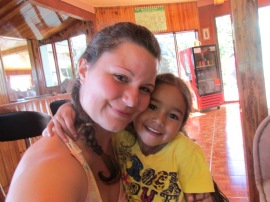
One of the most adorable kids I have ever met (pretty sure she said her name was Haley). She didn’t even know me and she reached out for a hug!

Yet another beautiful view of las montañas de Costa Rica on our way back to San José.
¡Hasta luego! ¡Pura vida!
-Cara




